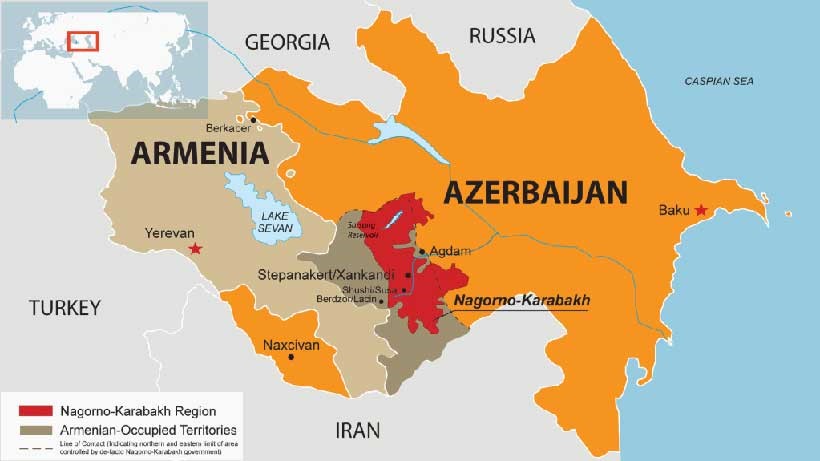New peace deal between Armenia and Azerbaijan
Context: Russia brokered a new peace deal between Armenia and Azerbaijan, the two countries that have been in a military conflict for over six weeks over the disputed region of Nagorno-Karabakh in the South Caucasus.
- During the course of the conflict, considered one of the most serious in recent years, over 1200 have lost their lives, while thousands have been displaced.
- The deal, which is meant to end the conflict between the two nations, was signed by Russian President, Azerbaijani president and Armenian prime minister.
- Since the conflict started in September, multiple ceasefire agreements have been signed between the two sides, but none so far have been successful.
So, what is the new peace deal?
- As per the new peace deal, both sides will now maintain positions in the areas that they currently hold, which will mean a significant gain for Azerbaijan as it has reclaimed over 15-20 per cent of its lost territory during the recent conflict.
- All military operations are suspended, Russian peacekeepers will be deployed along the line of contact in Nagorno-Karabakh for a period of five years.
- Refugees and internally displaced persons will return to the region and the adjacent territories and the two sides will also exchange prisoners of wars and bodies.
- A new corridor will be opened from Nakhchivan to Azerbaijan, which will be under Russian control.
What are the stakes for Russia?
- Russia’s role in the conflict has been somewhat opaque since it supplies arms to both countries and is in a military alliance with Armenia called the Collective Security Treaty Organisation.
- Russia has “traditionally good relations” with both countries.
What is the Nagorno-Karabakh region?
- Straddling western Asia and Eastern Europe, Nagorno-Karabakh is internationally recognised as part of Azerbaijan, but most of the region is controlled by Armenian separatists.
- Nagorno-Karabakh has been part of Azerbaijan territory since the Soviet era.

- When the Soviet Union began to collapse in the late 1980s, Armenia’s regional parliament voted for the region’s transfer to Armenia; the Soviet authorities turned down the demand.
- Years of clashes followed between Azerbaijan forces and Armenian separatists.
- The violence lasted into the 1990s, leaving tens and thousands dead and displacing hundreds of thousands.
- In 1994, Russia brokered a ceasefire, by which time ethnic Armenians had taken control of the region.
- While the area remains in Azerbaijan, it is governed by separatist Armenians who have declared it a republic called the “Nagorno-Karabakh Autonomous Oblast”.
- While the Armenian government does not recognise Nagorno-Karabakh as independent, it supports the region politically and militarily.
Have there been other ceasefire agreements?
- Even after the 1994 peace deal, the region has been marked by regular exchanges of fire.
- In 2016, it saw a Four-Day War before Russia mediated peace.
- The Organization for Security and Co-operation in Europe (OSCE) Minsk Group, chaired by France, Russia and the US, has tried to get the two countries to reach a peace agreement for several years.
What is the role of ethnicity in the conflict between the two countries?
- Ethnic tensions from decades ago have a crucial role in the dispute.
- While the Azeris claim that the disputed region was under their control in known history, Armenians maintain that Karabakh was a part of the Armenian kingdom.
- At present, the disputed region consists of a majority Armenian Christian population, even though it is internationally recognised as a part of Muslim-majority Azerbaijan.
How did the recent conflict start?
- Current escalation was “most likely” initiated by Azerbaijan.
- They were possibly a fallout of Azerbaijan’s bid to reclaim some territories occupied by separatist Armenians.
- Azerbaijan’s National Council called “military operation of the Azerbaijani army continues to clear the territories occupied by the enemy for almost 30 years” as a “day of exhaustion” and alleged Armenia has occupied regions around Nagorno-Karabakh with the “direct support” of Russia to create a “security zone”.



1.png)
